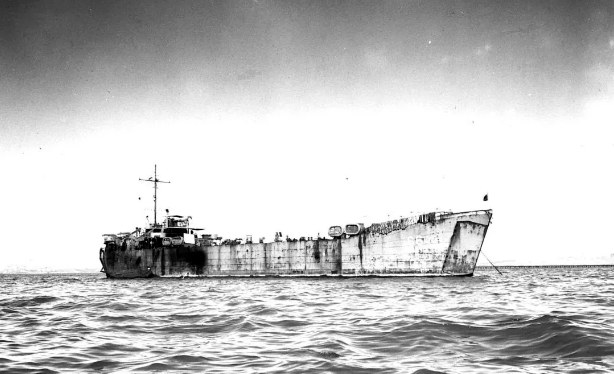People of the Philippines: I have returned. By the grace of Almighty God our forces stand again on Philippine soil—soil consecrated in the blood or our two peoples. We have come dedicated and committed to the task of destroying every vestige of enemy control over your daily lives, and of restoring upon a foundation of indestructible strength, the liberties of your people.
General Douglas MacArthur
U.S. Army, 20-October-1944
75 years ago, on 25-December-1944, after a 6-week campaign to liberate the Philippine island of Leyte, Allied forces under General Douglas MacArthur were mopping up the last vestiges of Japanese resistance. The invasion of the Philippines was one of the last major land battles of the Pacific War leading up to the surrender of Japan. By 26-December, MacArthur announced the end of organized resistance on Leyte. It was a fitting Christmas gift to the Philippine people, and MacArthur’s forces would pursue the enemy back to the island nation’s capital in Manila.
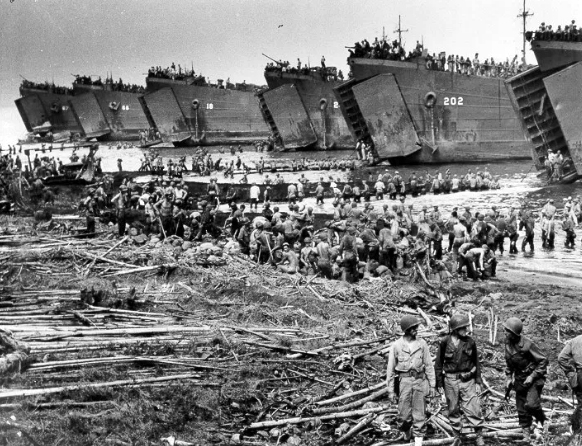
LST-66 (second from left) & other LSTs debarking troops and supplies on Leyte Island, Philippines. (U.S. Coast Guard Collection)
Coast Guard manned ships, such as LST-66, ensured a steady stream of troops, equipment and supplies to Allied offensives like the Battle for Leyte Island. At 328 feet in length, the LST (Landing Ship, Tank) was a product of British and American engineering genius, and the Allies’ desperate need for amphibious ships in the European and Pacific theaters. The largest of the Allies’ purpose-built landing ships, the LST carried 2,100 tons of troops, tanks, trucks, supplies and ammunition. A crew of 110 Coast Guard officers and enlisted men called LST-66 their home.
In the fall of 1944, the Allies launched one of the most strategically important amphibious operations of the war, a campaign to liberate the Philippines from Japanese occupation. In so doing, MacArthur would redeem his pledge made in 1942, before the surrender of the islands, to return and free them. More importantly, Allied control would cut-off the Japanese homeland from vital raw materials, such as the oil reserves located in the Dutch East Indies and Malaya, and isolated Japanese military units holding out as far south as Borneo.
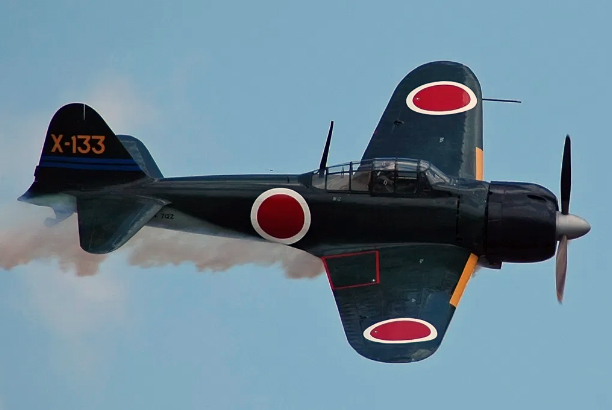
Japanese Zero fighters were used in the Philippines as kamikaze aircraft. (Commemorative Air Force/American Airpower Heritage Flying Museum)
Japanese military leaders knew all too well the strategic importance of the Philippines. Its loss would initiate the final chapter of a retreat to the home islands that had begun in mid-1942 with the Allied “island-hopping” campaign. To hold onto the Philippines, the Japanese military resorted to desperate measures. These included sending the last major units of the Imperial Japanese Navy on a suicide mission to destroy the Allied invasion forces, and a new aviation tactic termed “Kamikaze” or “Divine Wind.” Japanese kamikaze pilots flew one-way missions to crash-dive their fighters and fighter-bombers into Allied ships.
American military leaders decided on Leyte Island as the target of their first Philippine landings. One of the largest amphibious operations of World War II, the Leyte invasion included nearly 430 amphibious vessels supported by aircraft carriers and warships of the Navy’s 3rd and 7th fleets. On Friday, 20-October-1944, the LST-66 helped land the first of the invasion’s nearly 200,000 troops.
At Leyte, enemy resistance met Allied forces on land, in the air, and at sea. Entrenched Japanese troops fought U.S. Army units in the jungle while kamikazes crashed into Allied ships and Japanese fleets attacked the Allied armada in world history, Allied warships repulsed Japanese naval forces leaving most of the enemy’s warships damaged or destroyed.
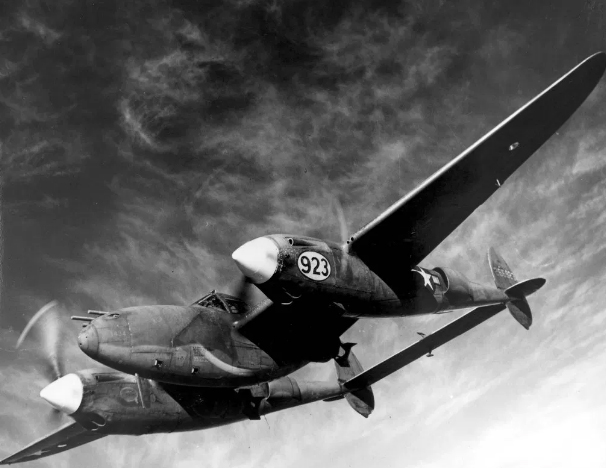
U.S. Army Air Corps employed the P-38 “Lightning” pursuit fighters in the Pacific theater of operations. (Courtesy of U.S. Air Force)
On Sunday, November 12, LST-66 returned to Leyte to land more troops and supplies. At 8:30 a.m., the LST-66 ran ashore on the grey sandy beaches near the town of Dulag, opened its protective bow doors and dropped its landing ramp. The shoreline had been cleared of enemy defenses, so the LST’s doors remained open for the day to deposit cargo and embark exhausted American troops from the invasion’s first wave. Members of the LST’s crew even had a chance to observe the anniversary of Armistice Day (now known as Veterans Day), a day late at the growing Allied military cemetery located not far from the beach. Little did these shipmates know that several of their number would soon lie in that hallowed ground.
In the afternoon, the LST-66 embarked men of the 75thJoint Assault Signal Company. Prior to the initial October landings, this joint Army-Navy reconnaissance unit had been inserted on the Leyte coast to identify Japanese defenses and communicate their location back to the invasion planners. After weeks of living in the jungle on C-rations, the recon men were happy to board a friendly vessel with bunk beds and hot chow. The weary troops made their way to the relative safety of the LST’s stern, out of range of enemy snipers. A lieutenant with the unit brought aboard a cockatoo perched on his shoulder, which drew a crowd of curious 66 crewmembers.
Throughout November 12, Japanese “Zero” fighter aircraft had made suicide attacks against the landing ships, so the U.S. Army Air Corps sent up P-38 fighters to protect the vessels. Fast and deadly, the fighter’s manufacturer named the P-38 the “Lightning,” but the Japanese called it “two planes with one pilot” because of its unique twin-fuselage and center cockpit design. At about 5:00 p.m., with two P-38s hot on its tail, a Zero appeared from behind the mountains on Leyte. The Lightnings hit the Zero with machine gun fire, suddenly broke off their pursuit, and rocketed skyward. A 66-crew member who saw the dogfight from the forward deck, recounted:
“Over the high area forward I saw two P-38 fighters zooming straight up as if to avoid our ship from being gunned down by us. At that very instance [sic], I saw and heard this roaring Japanese kamikaze plane with the meatball markings almost 15 feet directly overhead that is forever imprinted in my brain.”

General Douglas MacArthur returning to the Philippines on the beaches of Leyte Island in October 1944. (U.S. National Archives)
What happened next was a brutal shock to everyone. The wounded Zero zoomed straight for the Army and Coast Guard men gathered on the starboard side of the LST’s stern. In milliseconds, the enemy fighter impacted the LST’s deck, careened across the ship’s aft quarterdeck, sprayed aviation fuel over everything, exploded, and obliterated men and machines. The Zero left a swath of carnage and wreckage in its wake before crashing into the water. The lieutenant and one of his men were killed instantly with another seven Army men severely wounded.
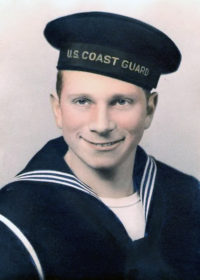
Early photo of LST-66 hero Robert Goldman in his Coast Guard uniform. Goldman will be the namesake for a new Fast Response Cutter. (The Goldman family)
The crash took a greater toll on the ship’s crew, with 4 Coast Guardsmen killed and 7 wounded. All that remained of the parrot were white feathers sprinkled over the twisted metal and mangled bodies strewn about the quarterdeck. In the aftermath, Pharmacist’s Mate 2nd class Robert Goldman swung into action treating the wounded and dying in spite of his own burns and shrapnel wounds. He was honored with the Bronze Star and Purple Heart medals, and will be honored as a Fast Response Cutter namesake next year.
LST-66’s dead were tagged for identification and sent ashore for burial in the same military cemetery that several of them had visited earlier that day. Like the fallen of LST-66, thousands of other Coast Guardsmen serving on the high seas never returned home. They made the ultimate sacrifice and remain part of the Coast Guard’s long blue line of brave men and women who go in harm’s way to defend the freedoms we hold dear.
About the author:
William H. Thiesen is a Historian for the U.S. Coast Guard Atlantic Area.





